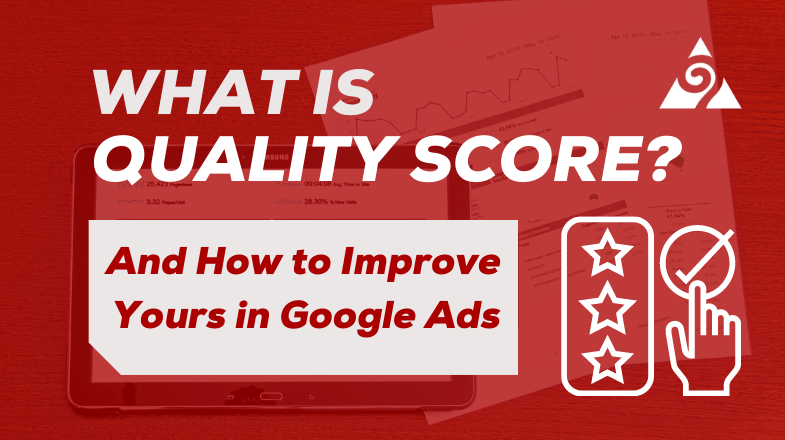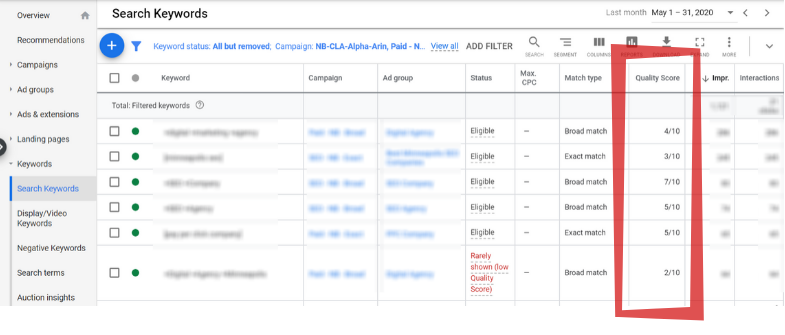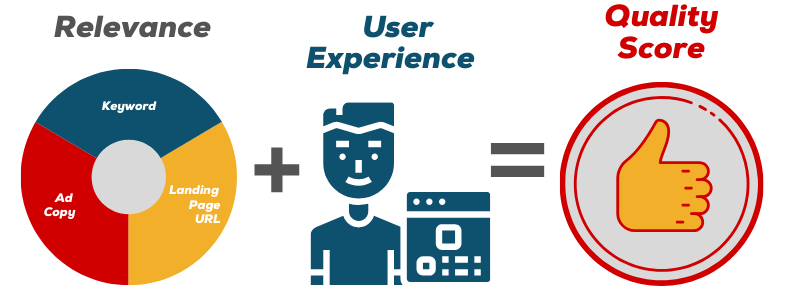If you’ve ever placed a paid search ad with Google, chances are you’ve heard of Quality Score. But, do you really know what it is or why it matters? If the answer is no, you’re in the right place.
This complete guide covers everything you need to know about the scoring system, plus expert tips on how to boost your score – and our powerful dashboard module to drive growth for your business.
- What is Quality Score?
- Why Does Quality Score Matter?
- How Does Google Determine Quality Score?
- Where To Find Quality Score In Google Ads
- How To Improve Quality Score In Google Ads
Having a high Quality Scores can signify that you have a high CTR, relevant ads, and stellar landing pages. This will usually result in lower CPCs (cost-per-click) and costs per conversions. Let’s discuss what determines your score, how often your Quality Score is calculated, and how to improve a Google Ads Quality Score.
What is Quality Score?
Quality Score is a Google Ads (formerly Google Adwords) metric that rates the quality and relevance of your search engine advertising on a scale of 1-10 based on your keywords, ads, and landing page. What does a high Quality Score indicate? Your ad is generally compelling and useful to the user.
Higher Quality Scores typically result in a higher ad rank and a lower cost-per-click. It allows you to get better value when it comes to budgeting. Put the work in to increase your scores and you’ll pay less for more conversions, leads, and sales.
There are 3 components of quality score that determine your score:
- Click-Through-Rate (CTR)
- Ad Copy Relevance
- Landing Page Quality and Relevance
Where To Find Quality Score In Google Ads
You may be wondering, “What is my Quality Score?” and how to see Quality Score in Google Ads.
Knowing how to check Quality Score is incredibly important.
- Your score can be found under the ‘Keywords’ tab within each ad group and can be sorted by customizable columns. Here, you can see each keyword’s score, ranked from 1-10, with an indication of whether each component of your score is at, above, or below average.
- The Google Ads Quality Score Report offers a full picture of your score and each component. Google explains how to do this.
How Often Does Quality Score Update?
Google Ads Quality Score updates in real-time. Every time your ad is triggered in a search Quality Score is calculated. You can even set up automated notifications for your quality score updates for each keyword.
Why Does Quality Score Matter?
Higher Quality Scores typically lead to…
- …more leads…
- …at lower costs.
This Google Ads rating system can have a major impact on your paid search advertising. Quality Score gives you an idea of your ad quality and how useful your landing page is. This score can define the well-being of your Google Ads account because Google uses it as a primary factor in determining Ad Rank. Your pay-per-click Quality Score will tell you how much you need to bid on keywords in order to secure that strong ad rank.
If that isn’t enough incentive to earn good scores, Google also rewards high Quality Scores with a discount on cost-per-click. Focusing on Quality Score translates to major cost savings on your Google Ads account and high SERP rankings.
Ad Ranking
Ad Rank = CPC Bid x Quality Score
This algorithm is Google’s way of leveling the playing field for paid ads. Just because you bid more than a competitor doesn’t mean you’ll rank first, especially if they have a higher Quality Score.
With all this in mind, it should now be clear that your Google Ad Rank and Quality Score are in direct correlation with one another, as well as how many leads you have the potential to gain.
Cost-per-Click Discounts
How does Quality Score affect CPC? A high Quality Score from Google Ads results in a reward; you get a discount because your PPC ad meets your potential customers’ needs.
CPC = Ad Rank of ad below you / Quality Score + $0.01
Imagine your CPC bid is $3.00 and your Quality Score is 8; your Ad Rank would be 24. The advertiser below you bids $4.00 and has a Quality Score of 5, making their Ad Rank 20.
Your savings breakdown:
$2.51 = 20 / 8 + $0.01
That’s 17% savings!
By now this should be clear: How Quality Score affects CPC is an inverse correlation. Read more about how the score can affect CPA.
How Does Google Determine Quality Score?
Google Quality Score is determined by three main components:
- Expected click-through-rate
- Ad copy and keyword relevance
- Landing page URL and experience
How does Google calculate Quality Score? The Google Ads Quality Score formula is not actually known outside of Google. However, you have the capability to see how Google measures the performance of each component in your score.
In your Google Ads account, you will find your score, as well as a metric measuring the performance of the three individual components. Each one will have a status of above, at, or below average. This status lets you know where to focus your attention in order to achieve a good Quality Score. For example, although you may have a high CTR, customers might find your landing page difficult to navigate, meaning you need to improve it.
The 3 Components of Quality Score
1. Expected Click-Through-Rate (CTR)
Expected CTR is Google’s estimate of the rate at which ad viewers should click through to your landing page. This component is likely the most important. If more people see your ad and click on it, that’s an easily measurable sign of your ad’s relevance and use.
Your ad will show up when a keyword (or keywords) matches a user’s query. This is why it’s important to incorporate keywords into your ad that are both general and specific. If your keywords are only general, your ad isn’t likely to find the right audience.
On the other hand, if your keywords are only specific, your ad is unlikely to appear in the SERP very often. Either scenario generates low CTR and fewer leads.
High CTR tells you that your keywords are relevant and generating leads, indicating that your ads are functioning properly and your ad spending is worthwhile.
2. Ad-Relevance
Ad relevance is Google’s evaluation of your ad’s relevance to a user’s query. This may sound similar to CTR, but it’s not. Google is smart! Not only does it identify keywords that match a user’s query, but it also identifies the user’s search intent, which is ad relevance.
This is where the succinctness of your keyword list comes into play. A list of keywords that are both general and specific is good for CTR, but don’t let the list get too broad. This can make your ad too generic or irrelevant to specific searches, lowering your ad relevance.
You should split your ad into more concise and strategic ad groups, instead of just peppering it with keywords. This will increase your ad relevance, which will increase your Quality Score, which will increase your ad rank, which will decrease your costs per click.
It’s the ripple effect!
3. Landing Page Experience
The landing page experience is an evaluation of how relevant and useful your landing page is to users. This is the third and final step of the user’s journey in Quality Score measurement.
They have clicked through to your relevant ad. Now that they’ve finally arrived on your site, what do they find? Is it organized? Are they happy? Confused?
If this metric is low, examine the following:
- Does the landing page deliver on what was promised in the ad?
- Did you just link to your home page?
- Or did you actually bring the user to a specific, relevant, and useful page?
- Is the page compatible with both mobile and desktop devices?
Are you sensing the theme? Relevance and usefulness are King among every component.
The user has made it far enough in their journey to get to your website, don’t fall short so close to the finish line. An excellent landing page provides excellent user experience and validates the hard work you put into getting a good Quality Score.
How To Improve Quality Score In Google Ads
Improving your quality score in Google Ads is possible by following two key concepts:
- Pick out excellent keywords for your ads and landing pages.
- Create an engaging online experience.
To boost your score, your strategy should achieve both.
Here are some tips to help you:
- Target hyper-specific keywords: Targeting long-tail or niche keywords using exact or phrase match types can enable your ad to show up for relevant searches more often
- Be aware of negative keywords: Using negative keywords can strategically reduce the number of irrelevant searches in which your ad appears. If the color orange is a keyword, make sure to flag ‘food’ as a negative keyword so that you don’t waste money on clicks.
- Group keywords into ad groups by theme or category: Doing this will ensure searchers are served ads that are highly relevant to their searches and are directed to landing pages that are specific to their search.
- Optimize ad text: In order to earn higher CTRs, your ads should stand out on the SERP. Continually test your ad text to keep it relevant, competitive, and compelling to searchers.
- Optimize landing pages: Make sure your keywords are embedded in your landing page and run tests on your landing page to see where you can improve.
- Try our Quality Score Dashboard Module: Follow our simple step-by-step instructions to improve your account-wide score. We have proven the success of our dashboard module. Now, you can use it to drive growth for your business.
DRIVE SUCCESS WITH OUR QUALIty Score Tool
Higher Quality Scores drive greater success in your Google Ads account by stretching your advertising budget further in order to drive higher conversion rates.
To achieve your goals, try our quality score dashboard module to get customized step-by-step instructions to improve your account-wide quality score. Want to know more? Let’s talk.
Reach out to an Augur to discuss your ads performance or visit our blog to explore digital marketing topics like SEO, SEM, and analytics.






